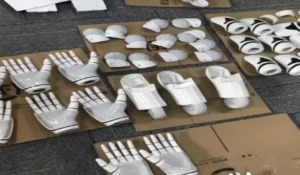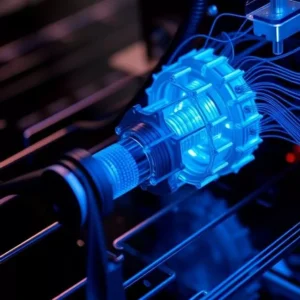In modern injection molding, cooling is often the most time-consuming phase of the production cycle—yet it’s also the most influential factor when it comes to productivity, part quality, and tool life. As manufacturers aim for faster cycles and tighter tolerances, conventional straight-line cooling approaches are falling short. Enter 3D Printed Conformal Cooling Channels—a breakthrough innovation that is redefining mold design and reshaping industrial performance standards.
This article explores how conformal cooling channels—enabled by advanced 3D printing technologies—are transforming mold efficiency and helping manufacturers produce better parts faster and more consistently.
1. Understanding Conformal Cooling Channels
Traditional cooling channels are typically drilled in straight lines through mold cores or cavities, often constrained by tool geometry. These channels do not always follow the part’s contours, leading to uneven cooling, hotspots, warping, and longer cycle times.
In contrast, conformal cooling channels are designed to “conform” to the shape of the part, closely following its complex geometry. These curvilinear pathways deliver more efficient and uniform heat removal from critical zones within the mold.
However, the complexity of such designs makes them nearly impossible to create using conventional drilling or machining techniques. This is where 3D printing—specifically metal additive manufacturing—plays a vital role.
2. The Role of 3D Printing in Moldmaking
3D printing, particularly Direct Metal Laser Sintering (DMLS) or Selective Laser Melting (SLM), enables the fabrication of intricate internal features directly into mold inserts. With this method, designers can incorporate organic-shaped, branching, or spiral cooling channels directly inside mold components that would be unachievable by subtractive manufacturing.
The use of 3D printed conformal cooling channels is not limited to a specific industry—it benefits molders across automotive, packaging, electronics, medical devices, and consumer goods sectors.
3. Key Benefits of 3D Printed Conformal Cooling Channels
a. Faster Cycle Times
One of the most significant advantages is the reduction in cooling time, which typically accounts for 50% to 70% of the molding cycle. Because conformal cooling channels are closer to the mold surface and more uniformly distributed, they remove heat more effectively, reducing total cycle times by 20% to 40% in many cases.
b. Improved Part Quality
Inconsistent cooling can lead to warpage, sink marks, and internal stresses in molded parts. With uniform thermal control, 3D printed conformal cooling channels minimize temperature gradients, leading to:
- Better dimensional stability
- Fewer visual defects
- Reduced internal stress
- Improved repeatability
This is especially important in industries like medical devices or electronics, where tolerances and aesthetics are critical.
c. Longer Tool Life
Hotspots and thermal shocks contribute to premature mold wear, corrosion, and cracking. With optimized thermal management, mold inserts experience less thermal fatigue, resulting in longer life cycles and reduced maintenance.
d. Energy and Material Savings
Because conformal cooling reduces the overall cycle time and improves first-pass yield, manufacturers save on energy, material waste, and rework costs. Shorter cycles mean lower power usage per part, and better cooling reduces the chance of scrap due to defects.
4. Design Freedom and Optimization
Traditional channel design is limited to straight bores that avoid ejector pins, cores, and other mold features. But with 3D printing, engineers can:
- Route channels around structural features
- Integrate multiple cooling zones
- Use variable cross-sections for flow control
- Design branching (tree-like) channels for uniform flow
These options open the door to topology-optimized designs, where software simulations help create the most thermally efficient geometry possible. The result is a mold that performs better, lasts longer, and produces higher-quality parts.
5. Case Studies and Industry Applications
-
Automotive Industry
A tier-1 supplier redesigned an injection mold for a complex under-hood component using 3D printed conformal cooling. The result: a 35% reduction in cycle time, improved part flatness, and elimination of warpage-related failures.
-
Medical Devices
For a diagnostic device housing, even minor warpage was unacceptable. Conformal cooling allowed for uniform shrinkage, meeting tight tolerances and increasing the yield rate from 85% to 98%.
-
Packaging Industry
In high-volume thin-wall packaging, time is money. By applying conformal cooling to cup molds, one company increased output by millions of parts annually due to the shortened cycle time and fewer tool stoppages.
6. Challenges and Considerations
Despite its advantages, integrating 3D printed conformal cooling channels into production requires thoughtful consideration:
- Upfront Cost: While 3D printed inserts may be more expensive initially, ROI is typically achieved quickly through faster cycles and less scrap.
- Design Expertise: Successful implementation requires CAD skills, thermal simulation, and knowledge of additive-friendly geometries.
- Material Choice: Not all 3D printable metals behave the same. Common materials include maraging steel, stainless steel, and tool steels, each with unique properties.
- Post-Processing: Printed parts require finishing operations such as heat treatment, polishing, and possibly EDM to ensure mold-ready performance.
Collaborating with a knowledgeable manufacturer or service provider can help navigate these technical requirements and deliver reliable results.
7. Integration with Smart Manufacturing
3D printed conformal cooling channels are not just a physical innovation—they are also a gateway to intelligent mold management, aligning perfectly with Industry 4.0 practices. When paired with embedded smart temperature sensors, flow meters, and IoT-enabled monitoring systems, these molds become dynamic, self-reporting tools that enable real-time thermal diagnostics.
By capturing granular data during each molding cycle—such as coolant temperature differentials, pressure fluctuations, and heat distribution across the cavity—manufacturers can:
- Optimize coolant flow dynamically based on material type or ambient conditions
- Detect early signs of scaling, blockages, or thermal imbalance
- Adjust mold temperature setpoints on the fly for complex or multi-cavity molds
- Track mold performance trends over time to predict wear or failure points
This data-driven approach facilitates predictive maintenance and closed-loop process control, minimizing unplanned downtime and ensuring higher-quality outputs. For multi-machine facilities, such connectivity enables centralized dashboards where technicians can remotely monitor multiple molds and intervene as needed—supporting lean manufacturing goals and continuous improvement.
Ultimately, integrating smart technologies into conformal cooling systems transforms molds from passive tools into intelligent production assets, giving manufacturers a competitive edge in precision, speed, and operational transparency.
8. The Future Outlook
As additive manufacturing matures, costs are decreasing, printer speeds are improving, and more manufacturers are realizing the competitive advantages of conformal cooling.
In the near future, we may see:
- Hybrid molds combining conventionally machined and 3D printed components
- Multi-material printing for integrating cooling, structure, and insulatio
- AI-assisted thermal design for automatic optimization
- Greater standardization of materials and processes
Companies investing in these technologies now will be better positioned to meet future demands for high precision, energy efficiency, and sustainable production.
Conclusion: Where Efficiency Meets Innovation
The introduction of 3D Printed Conformal Cooling Channels represents a pivotal shift in moldmaking and plastic part production. By enabling faster cycle times, better part quality, and longer tool life, conformal cooling is no longer a luxury—it’s a strategic advantage.
Whether you’re producing high-precision components or mass-market goods, optimizing thermal control is key to improving profitability and competitiveness.
If you’re considering integrating 3D printed conformal cooling into your mold designs or looking for professional support in advanced moldmaking and printing services, www.gtproto.com offers tailored solutions for businesses embracing innovation.
Their experience in custom tooling, precision printing, and modern manufacturing technologies positions them as a valuable partner for companies aiming to elevate product quality and operational efficiency.
To learn more or discuss your project ideas, visit www.gtproto.com or contact their team for insights and recommendations.
Let innovation flow—cooler, faster, and smarter.


